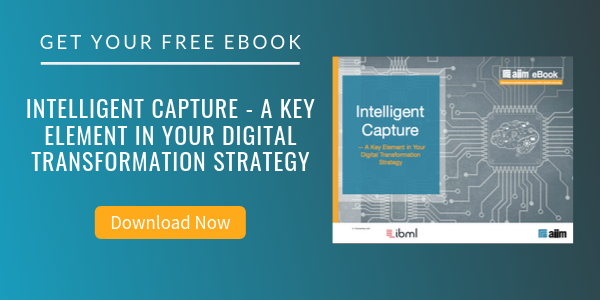
8 Things to Consider When Deciding to Buy or Rent OCR Capabilities
Document Management | Capture and Imaging
"Should I buy or rent OCR capabilities?" This is a common question businesses ask themselves when they're starting to get serious about their capture strategy. If you're wondering if you should purchase a document management application for your data extraction and forms processing or outsource the job to a service bureau, the answer is a dissatisfying "Well, it depends."
Answering this question should include making a solid business case that includes a cost-benefit analysis using a formula like Net Present Value (NPV) or Internal Rate of Return (IRR) to determine the return on investment.
However, the answer usually comes down to the company's philosophy of building versus renting. The renting companies believe in focusing on their core competency and reducing costs while outsourcing anything that falls outside core functions. The building companies are often more focused on maintaining control. The following should be considered in terms of answering the in-house vs. outsourcing question for your organization.
Here are eight things you should consider when deciding to buy or rent OCR capabilities:
-
Are your forms paper or digital?
If paper, they need to be digitized by using a fax service (instead of fax machines) or use scanners to digitize the paper so that they can be entered into a digital workflow to begin the data extraction process.
-
Will the images be skewed or of poor quality?
OCR software does not read poor image quality or low dpi images very well. If the image is skewed, it will need to be enhanced using image enhancement software for an accurate read. This will require the purchase of an additional software package.
-
What kinds of forms are being received; structured or unstructured?
Structured forms have fields found in the same place on every single form (e.g., a loan form). Purchase orders and invoices are examples of unstructured forms, where the fields may vary.
Despite what many software vendors claim, most OCR software platforms are not incredibly accurate in handling unstructured forms. It wouldn't be unfair of you to ask the software vendor to backup their accuracy claims with a guarantee.
Another question you should ask is how they handle false positives. A few common examples of false positives are when the OCR software recognizes the seven as a one or a three as an eight.
-
What accuracy rate is required to guarantee a reduction in the labor costs for the data entry task?
This is an important component of your business case. If your accuracy rate with OCR software is in the mid-80s, will it justify a reduction in full-time employees?
-
What is the lifespan of the hardware and software before it is obsolescent for your IRR formula?
Our research suggests that the lifecycle for OCR software is between six and 18 months. You will want to account for this in your ROI formula. Consider the time of implementation, training, and depreciation in deciding whether an in-house solution is really the best choice.
-
How will the OCR software interface with your document management package or image archiving solution? Is a workflow required?
What is the capital expenditure for archiving hardware and software? We have found that many legacy ERP systems using an AS400 cannot accept a file upload.
-
What are your overall requirements and costs?
What is the annual cost for hardware, software, training, maintenance, IT support, and implementation for an in-house OCR solution versus the transactional cost of using an OCR Service? How much will the learning curve cost? What is the cost of implementation delays?
-
When considering the capital expenditures equation, is risk part of your discount factor for the NPV equation for an on-premises solution?
Too many businesses turn to an OCR service bureau only after their internal OCR document management project failed. Outsourcing offers a guarantee in the form of service level agreements.
For niche applications like OCR document management for automated data entry, one must consider both the hard cost and soft cost of processing paper when evaluating against the cost of maintaining the status quo. Depending on the application, the soft cost often adds up to more than the hard cost. For example, consider the cost of mistakes caused by data entry errors. These costs should include, rekeying, stocking, shipping, and customer service.
With today’s movement toward SaaS and cloud computing, I believe the argument becomes even stronger toward outsourcing document management for data extraction using an OCR platform.
About John Mancini
John Mancini is the President of Content Results, LLC and the Past President of AIIM. He is a well-known author, speaker, and advisor on information management, digital transformation and intelligent automation. John is a frequent keynote speaker and author of more than 30 eBooks on a variety of topics. He can be found on Twitter, LinkedIn and Facebook as jmancini77. Recent keynote topics include: The Stairway to Digital Transformation Navigating Disruptive Waters — 4 Things You Need to Know to Build Your Digital Transformation Strategy Getting Ahead of the Digital Transformation Curve Viewing Information Management Through a New Lens Digital Disruption: 6 Strategies to Avoid Being “Blockbustered” Specialties: Keynote speaker and writer on AI, RPA, intelligent Information Management, Intelligent Automation and Digital Transformation. Consensus-building with Boards to create strategic focus, action, and accountability. Extensive public speaking and public relations work Conversant and experienced in major technology issues and trends. Expert on inbound and content marketing, particularly in an association environment and on the Hubspot platform. John is a Phi Beta Kappa graduate of the College of William and Mary, and holds an M.A. in Public Policy from the Woodrow Wilson School at Princeton University.



